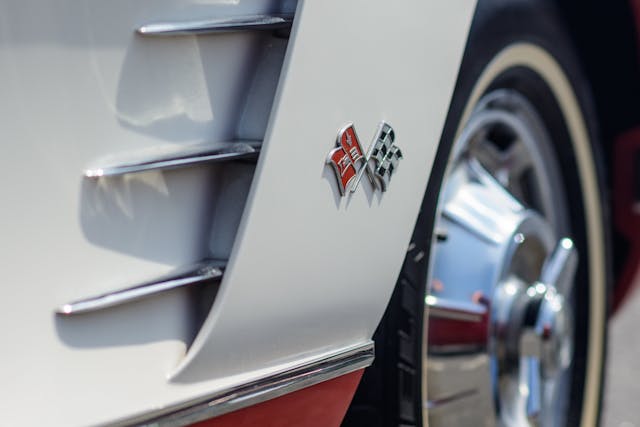How I saved my neighbor’s vintage Corvette from death by fire
It was a regular Saturday. I was tinkering with a sticky carburetor float on my Lotus Esprit when a neighbor pulled up in his mint 1959 Chevrolet Corvette.
We got to talking, bonding over the pitfalls of fiberglass bodywork, and other assorted highs and lows of the old car ownership. We exchanged numbers and agreed to head out on an early Sunday morning coffee run in our classics.
The weather was hot. When he went to restart the Vette it just wouldn’t play ball. We wondered if it was flooded or the high temperatures were causing a fuel evaporation problem. Talk, however, is cheap and it was clear that he couldn’t leave his car in the road, so my wife and I began to roll it gently to the curb.
As we pushed, ominous black smoke started spewing from under the hood. My neighbor hopped out and popped the engine cover. Flames leapt out from the edges and I shouted for him to close the hood, while I sprinted back to the Esprit to grab an extinguisher.
Specifically, I grabbed a recently-purchased Fire Safety Stick, which had been recommended by a fellow Esprit enthusiast. Lighter (just 7.6 ounces) and more compact than a regular powder extinguisher, the stick is not unlike a flare, but with the opposite effect.

I rapidly read the instructions, removed the safety cap and struck the top of the stick with the igniter. Inside, the triggered chain reaction caused the stick to emit a powerful spray of nitrogen and potassium free radicals, which starve any fire of oxygen.
Mr. Corvette (he prefers to keep his name out of it) opened the hood again and I pointed the stick at the air filter where the flames were spewing out. He then grabbed it off me to run around the other side of the car and finish the job. Within a minute the fire was out, and a near-$200,000 vehicle was saved.
Amazingly, there was only a small amount of blistering on the hood from the heat. Even more remarkably, when the owner had to move the car a day later it started on the button.

The people behind the Fire Safety Stick (sold as Element in the U.S.A.) told me that’s down to the fact that the product leaves almost no residue behind.
Andrew Robinson from Argento Global Solutions, the company that imports the stick in the U.K., explains that’s why many motorsport teams have now started carrying Fire Safety Sticks in addition to traditional plumbed-in extinguisher systems.
The technology, he explained, was actually invented in Soviet Russia during the space race, but it wasn’t until 20 years ago or so that an Italian company bought the rights and began manufacturing and selling the devices.
Having seen the stick in action, I immediately ordered another and highly recommend you do the same. Meanwhile, my neighbor, who has a collection of 11 classics, has probably become their biggest customer.
***
Check out the Hagerty Media homepage so you don’t miss a single story, or better yet, bookmark it. To get our best stories delivered right to your inbox, subscribe to our newsletters.



I’ve had carburetor fires before and cranked the engine which sucked the flames back into the intake which extinguished them. But that was always while working on the engine – usually a timing issue – and the air cleaner was off, no fuel leak and the fire limited to the top of the carburetor. If the filter element is burning, that’s a different story and you need a fire extinguisher.
Bought some a few years ago. Hoping to never needing them!
I was hoping this product would do the job in case of a fire, so I did a google search looking for videos of this product in use on an engine compartment-type fire. All I found were videos that showed it not working on similar fires, with none showing it actually in use on a car fire.
If someone can post a link showing it putting out a car fire, please post it here. Thanks.
I read this article then bought two. Sorry I did. My friend sent me several links on YouTube showing these used on gas/grease fires. For example: https://www.youtube.com/watch?v=dCaPUYKs5Zc Not effective as stated in the article and a fair amount of $$. Thanks Hagarty.
Explicit video. ineffective.
A $20 powder extinguisher is probably more effective
The creator of that video mentions in the comments of said video that he sent the video to the company and an engineer reached out and they discussed that this product is not intended for open air use like he tried. The wind made it ineffective. A perfect solution for every situation? No, but neither are most fire extinguishers as the various classes and types all have situations where they excel and are lacking.
I bought a pack of three,
comes from UK, it was about us$88.00 each.
Hope I never have to use them.
Thank You
This fire sounds like it’s caused by carburetor, percolation, common in early Holley and Carter carbs due to heat soak. happened to me once in a Camaro with a Holley carburetor 350 was put out with a powder extinguisher by a passerby, minor wiring damage. Lots of clean up from the powder. I keep halon fire extinguishers in my boats and cars now however the small 1 pound hand models, would be inadequate for a larger fire. Halon will put out lithium ion battery fires as well, quite a bit of a cooling effect, which helps. I have not tried to buy the small halons recently. I think we can still recharge our on board systems. i’ll give these a look. PS put the fire out as fast as possible!
Just curious, was the actual cause of the fire ever determined?